|
CONTENTS
First Backboards
First Olympic Basketball
Not a Bad Three Games
Ice Capades for Bill Russell
Value of a Blocked Shot
Basketball
Facts - I
Basketball Facts - II
Basketball Facts - III
Basketball Magazine
Golden
Rankings Home |
Interesting Basketball Facts - IV
James Naismith, a physical education professor from McGill University in Montreal, invented basketball in December 1891 at the YMCA in Springfield MA.
In the beginning, the basket was a peach crate nailed to the gym's balcony. This caused several problems.
- The fans could interfere with players' shots.
- Without backboards, there were no rebounds
Within two years, backboards were built out of chicken wire.
- In 1904, wooden backboards became mandatory for safety reasons due to injuries suffered from the chicken wire.
- By 1909, glass backboards became common because of their aesthetic appeal.
- Today's backboards are made of fiberglass, which is transparent like glass but much harder to break.
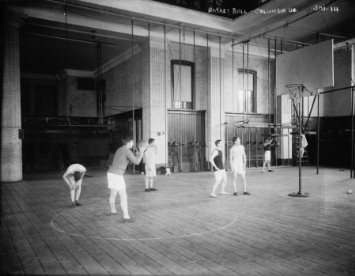
Basketball Practice at Columbia University, early 1900s |
Basketball became an Olympic event at the 1936 games in Berlin. The United States won its first of seven consecutive gold medals, with Canada second and Mexico third.
23 nations entered, making basketball the largest team tournament at the Olympics. The International Basketball Federation experimented with outdoor basketball, using lawn tennis courts. As you would expect, bad weather caused problems, especially during the final game. The AP summary read like this:
The United States basketball team won the first Olympics championship today by defeating Canada 19-8 on a court swept by wind and rain and deep in mud.
It's fitting that the U.S. and Canada played in the first finals because basketball was invented by a Canadian, James Naismith, while he coached in the United States.
Read more: Sports Illustrated (1996): "The Dream Team of 1936"
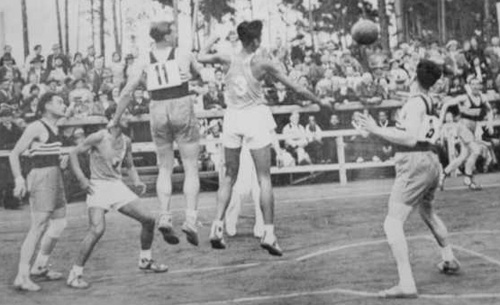
Action from 1936 Olympics
|
A player once scored 188 points in a single game. Furthermore, he scored 103 and 150 in his next two contests. And all to make a point.
- The year was 1953. The player was 6'6" John Barber of Los Angeles State (now California State University at Los Angeles). His coach, Sax Elliott, was upset because Bevo Francis of Division II Rio (Rye-o) Grande College in Ohio was attracting nationwide attention for averaging over 45 ppg while playing many games against junior colleges, vocational schools, and military base teams.
- To prove that anybody could score at will against lesser opposition, Elliott scheduled a game against the Chapman College JV team. He stationed Barber under the goal and told the other players to feed him the ball every time. As a result, John racked up 188. The fact that the lane was only 6' wide in that era (until 1957) gave Barber still another advantage besides his height. LA State won the "contest," 206-82. Sax instructed Barber to expend little effort playing D. So he rarely ventured past the midcourt line. He made 92 of 153 FG attempts.
- The next day, Barber tallied 103 against Los Angeles Community College's JV.
- The day after that, he connected on 73 of 97 FGs for 150 points against a team of Los Angeles reporters.
- His school disclaimed Barber's totals as competitive records, and the NCAA Rules Committee soon ratified a proposal by the National Basketball Coaches Association that only games between varsity teams of four-year colleges would be recognized as official contests.
Barber's story is interesting beyond his amazing point totals.
- A country boy from Atlanta TX, Barber went to California to play football for UCLA. When his grades wouldn't allow him to be a Bruin, he enrolled at East Los Angeles JC. He made All-Conference as a two-way end before transferring to LA State.
- At State, he lettered in football, basketball, and track. Twice he was named the school's athlete of the year. In basketball, he was a two-time All-California Collegiate Athletic Assn. pick and twice led the conference in scoring, averaging 22.5 points over two seasons.
- On the court, Barber could double his size because he could high jump 6'6". "If you threw the ball anywhere near the basket I could funnel it or stuff it or whatever," he later said of his career.
- Barber played five games with the St. Louis Hawks in the 1956-57 season but quickly tired of "collecting splinters" on the bench and dealing with the racism of fans and teammates.
- He barnstormed for several years with Goose Tatum's Harlem All-Stars because they paid better than the Harlem Globetrotters. He later served as a recreation director in Los Angeles for more than 20 years.
Sax Elliott is also an interesting character. He was one of the charter inductees in 1985 into the Cal State LA Athletics Hall of Fame. He is credited with introducing a number of innovations to basketball.
- The glass blackboard
- The square on the backboard behind the rim to aid shooting accuracy
- The multi-colored basketball, later adopted by the American Basketball Association
Unfortunately, I couldn't find a picture of either Barber or Elliott.
|
Reference: "He Scored 188 Points So His Coach Could Make One," Los Angeles Times, February 19, 2007
|
Ice Capades for Bill Russell
Red Auerbach became coach of the Boston Celtics in 1950. He joined a franchise that was almost bankrupt and had not had a winning seasons in the four previous years of the new NBA. The '49-50 team had gone 22-46.
Auerbach became the only coach, the G.M., the scout, the marketing director, and the PR director. The only person on the bench other than his players was Buddy LeRoux, the trainer. Despite all these responsibilities, he immediately turned the franchise around on the court. His first Boston team, led by "Easy Ed" Macauley and Bob Cousy, finished 39-30. The following seasons went like this.
- 1951-2: 39-27
- 1952-3: 46-25
- 1953-4: 42-30
- 1954-5: 36-36
- 1955-6: 39-33
The team finished 2nd or 3rd each season but could not get over the hump and win the Eastern Conference. That changed in 1956-7 with the acquisition of a new center.
- Bill Russell had just completed his career at the University of San Francisco that included NCAA championships his junior and senior seasons.
- Bill Reinhardt, Auerbach's college coach at George Washington, called to tell him that he had to draft Russell.
- The Celtics' only scout, Red himself, had been busy every basketball season coaching an NBA team in the northeast. It was typical of the times that he hadn't seen the best college player in the land even one time. However, trusting what Reinhardt (and others) told him, he went about pulling strings to get Russell.
- Scheduled to draft #7, Boston needed to move up much higher. So Red traded McCauley and the #7 pick to St. Louis for the Hawks' first round spot.
- The only problem was that St. Louis would draft #2, not #1. The Rochester Royals possessed the top choice. So Auerbach got Celtics owner Walter Brown to promise Royals' owner Les Harrison that he would send the Ice Capades to Rochester if the Royals did not take Russell with the first pick.
- Just when everything seemed set, Hawks' owner Ben Kerner insisted on F Cliff Hagan being included in the deal. That gave Red pause because he liked Hagan. Also, not all his advisors thought Russell should be the first pick. "He won't score in the NBA," some warned. But Auerbach felt that Bill was the key piece to the championship puzzle. So he sent Hagan to St. Louis.
- Rochester chose Sihugo Green of Duquesne, and the Ice Capades sold out in Rochester two weeks later.
- The Celtics won the 1957 NBA championship in Russell's rookie season, the first of 11 titles in the next 13 years.
- After winning the ninth title, Red retired at the young age of 48 to become full-time GM. He appointed Russell as his successor, making Bill the first African-American coach in the NBA. The Celtics won two more crowns under Bill's leadership.
|

Red Auerbach
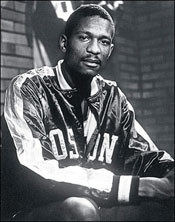
Bill Russell
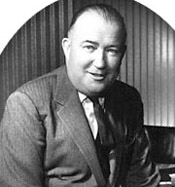
Walter Brown
|
|

Yao Ming
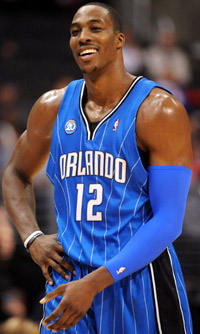
Dwight Howard

Tim Duncan
|
John Huizinga was the dean of the University of Chicago's School of Business.
- In his spare time, he loved to watch basketball, especially the NBA. He had played G at Pomona College (CA).
- Through a mutual friend, he met Yao Ming when the young Chinaman was trying out for NBA teams. He became Yao's agent and negotiated contracts worth over $100 million for his client.
Using his business training, Huizinga analyzed NBA games in more depth than the average fan.
- In part because his 7'6" client was such a defensive force, John focused on shot blocking.
- He noticed that some blocked shots had more value than others. For example, blocking a breakaway layout that ended in possession by the blocking team was more crucial to a team than blocking an off-balance, desperate 3 as the shot clock wound down.
The NBA, however, simply counts the number of shots blocked without regard to their value.
- Dwight Howard led the league in 2008-9 with 232 blocks on his way to winning the defensive MVP award.
- Tim Duncan trailed far behind with only 149 blocks.
Huizinga teamed with sports statistician Sandy Weil to quantify shot blocking. They ranked each block according to this system.
- Blocking a "non-jump shot" (such as a layup) was worth 1.5 points because they determined that opponents on average made 1.5 points per successful non-jump shot.
- Blocking a jump shot was worth 1 point.
- Blocking the shot back to the opponent was given one value.
- Blocking the ball out of bounds so that the opponent retained possession was worth slightly more.
- Blocking the ball to a teammate earned the most value.
- Finally, they factored in goaltending, the least valuable block because it gives two points to the opponent and often results in a foul and an additional point.
Huizinga and Weil applied their scale to seven seasons of NBA play (2002-2009). Their system resulted in a much different ranking of the shot blockers for 2008-9.
- Duncan's 149 blocks totaled 167 points in their value-added system. Tim often tipped the ball to a teammate. Also, he had no goal-tends for the third season in a row.
- Howard's 232 blocks accumulated only 123 points. He often blocked shots into the stands and goaltended many times.
Here are the top ten players in value-per-block during the seven years of the study.
| Player |
Season |
Blocks |
Value per Block |
| Tim Duncan |
2008 |
149 |
1.12 |
| Andrew Bogut |
2008 |
137 |
1.10 |
| Rasho Nesterovic |
2003 |
117 |
1.09 |
| Zydrunas Ilgauskas |
2006 |
136 |
1.08 |
| Ben Wallace |
2007 |
156 |
1.07 |
| Ben Wallace |
2008 |
120 |
1.07 |
| Tim Duncan |
2005 |
171 |
1.06 |
| Chris Kaman |
2006 |
110 |
1.05 |
| Tim Duncan |
2006 |
162 |
1.05 |
| Tim Duncan |
2009 |
126 |
1.05 |
Now the ten players with the least value-per-block averages.
| Player |
Season |
Blocks |
Value per Block |
| Dwight Howard |
2008 |
232 |
0.53 |
| Erick Dampier |
2003 |
165 |
0.60 |
| Stromile Swift |
2003 |
119 |
0.63 |
| Erick Dampier |
2004 |
146 |
0.66 |
| Samuel Dalembert |
2004 |
220 |
0.66 |
| Dwight Howard |
2007 |
181 |
0.67 |
| Samuel Dalembert |
2007 |
201 |
0.67 |
| Joel Przybilla |
2005 |
200 |
0.67 |
| Shaquille O'Neal |
2009 |
120 |
0.68 |
| Dwight Howard |
2009 |
191 |
0.69 |
Wouldn't it be great if enough game footage were available to apply the Huizinga-Weil scale to seasons when Bill Russell and Wilt Chamberlain played.
|
Reference: Scorecasting: The Hidden Influences Behind How Sports Are Played and Games Are Won, Tobias J. Moskowitz and L. Jon Wertheim (2011)
Back to Top
|
|